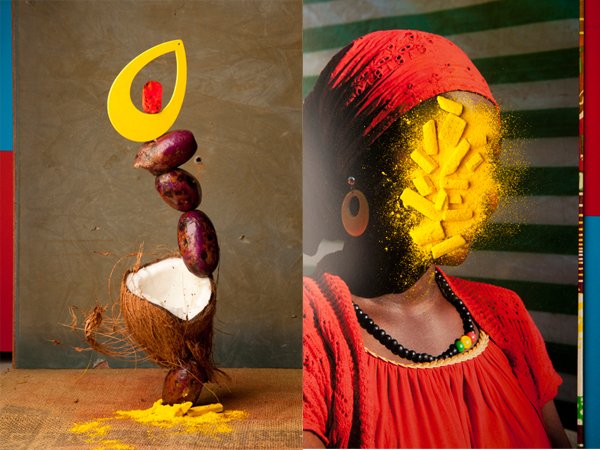United Kingdom –
Every now and then, a photography book comes along that looks completely different. Dalston Anatomy by Lorenzo Vitturi is one of those books, a sculptural, colour-soaked dance through the community of Dalston’s Ridley Road Market.
The photographic music starts with the cover, which is decorated with an African-themed fabric sourced in the market. Open the pages and the colour gets straight into its rhythm. A statue of pig trotters against a red background segue into a portrait of a local resident wearing a Hello Kitty Hat with that red background picking up the beat. The white goes to green and then we see a collage consisting of a 2-dimensional portrait of a woman, her hair wrapped in white fabric, with another piece of cloth nailed over the portrait.
Right from the start, Vitturi’s organic colour-based approach jumps off the page. This is a book with a rhythm and a sophistication that goes beyond the simple two-dimensional image. Instead pictures and objects are modified to create what Vitturi sees as an anatomical dissection of the market, products and people of Ridley Road.
 Dalston Anatomy©Lorenzo Vitturi
Dalston Anatomy©Lorenzo Vitturi
Vitturi’s role as a photographer is to reimagining these elements into a sequence that revealed the deeper layers of the market; Vitturi sees himself as a photographic surgeon, using the scalpel of his lens to uncover the anatomy of Dalston’s Market.
Strangest of all in this mix are the sculptures that Vitturi made and photographed in his studio. These are precarious affairs, short-lived concoctions that call to mind the primitive art that can be found in Sigmund’s Freud’s house, non-mechanical combines that are half-Danny Treacy and half Robert Rauschenberg.
One sculpture is of half a cassava sitting on a fish head, with acid-coloured hair breads reaching out. At the base of the sculpture there is a scattering of a pink powder. The Freudian reference invites us to analyse the contents of the sculpture, and lead us into the cosmopolitan community that forms the clientele for the market.
Another sculpture shows unknown tubers piled on top of a cracked open coconut. At its base is a sprinkle of yellow powder. Across the page the yellow powder appears again, scattered over the face of a woman dressed in red. She’s wearing beads in the colours of Ghana, part of an continuous reference to the diversity of the people who work, shop and live in Ridley Road.
The ethnic make-up of the market is further explored the text that runs through the middle of the book; pawpaw or papaya, Jesus Saves, Dominican Mangoes, Yiddish women in wigs and people come and gone are all referenced. African, Asian, Hindu, Muslim and Jew rub together. There are Pakistanis and Turks and old-style cockneys from an area of London that has been first port of call for newly arrived migrants to the city for hundreds of years. Where once it was Jews and Jamaicans fleeing pogroms or seeking work, now Turks and Poles who are coming into the area; and using its market as a recognizable place of refuge in a city that is less welcoming to the outsiders than it once was.
 Dalston Anatomy©Lorenzo Vitturi
Dalston Anatomy©Lorenzo Vitturi
And with that wealth comes conformity and a brutal blandness. Dalston Anatomy is the antithesis of bland. It is a book that celebrates the diversity of life; food, of dress, of being who you are. In terms of structure, it is supremely made, with colour, texture and shape feeding into a nuanced view of how the people, places and goods of Ridley Road Market interact. More importantly than that, however, it is a book that has a heart, a rhythm and a soul. And that is what makes it so very special.
Publication date: October 2013
Place of Publication: London
Designer: Tankboys
Editor: Bruno Ceschel, Francesca Seravalle and Lorenzo Vitturi
Imprint: SPBH Editions and JibiJana
Price: £40
Edition size: 700, signed and numbered
Additional Contributor: Sam Berkson
Format: Hardcover, Vlisco fabric
Size: 19 x 26cm
Number of pages: 168
Type of printing: Lithography
Number of pictures: 110
Photography feature- Colin Pantall is a UK-based writer, photographer and Senior Lecturer at the University of South Wales, Newport.
















